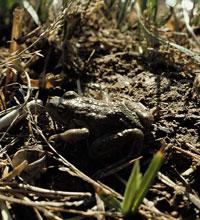Apo Pikarta, the unknown cruise

In view of books, books, magazines, documentaries, etc. that exist in the market, the basic knowledge of the vertebrates of our environment seems, in most cases, acquired for some time, and we place in our imagination the mysterious animals of life hidden in the most remote regions, which could not be close to home.
Fortunately, however, the source that exploits the curiosity of nature lovers has not yet been exhausted, and as for many aspects related to their way of life that are unknown to us, today there are many machines. Among European amphibians is the mottled toad (Pelodytes punctatus), one of the most unknown species.

The mottled toad (Pelodutes punctatus) is a slender frog-shaped frog, with long legs, with triangular head and pointed end. Due to its small size, its length from the anus to the end is difficult to reach to 5 cm, usually between 3’5 and 4’5 cm. The hind legs are long and thin, and these through the back of the animal and stretching them towards the head, the heel joint reaches the eyes if it is male and even the eardrum if it is female.
The fingers are also thin and almost free, including the interdigital membrane. His eyes are large and outstanding in the dorsal area, being one of the characteristic features of the species the presence of a vertical beginini in the yellow canvas painted black. On the other hand, the eardrum is small, with a diameter ranging between 1/3 and 2/3 of the eye. Behind the eye, and above the eardrum, a glandulose part appears and, in addition, in the back part, the skin is dressed in small clumps and garachas of green or dark brown color aligned longitudinally.
As for the color of the animal, it can be very different, but the dorsal part is usually greenish gray or light brown, decorated with numerous green or brown spots. The ventral part, however, is quite whitish and granulose in the belly, being more yellowish in the legs.

But when we want to set aside the description and explore its way of life, we realize it is quite unknown. And is that the mottled toad is an extremely dry and solitary species of nocturnal activity, so it is quite difficult to know its activities. In any case, and according to what we know, the mottled toad is a great jumper and a very thin screwdriver, which often confers a semi-natural behavior, that goes up to the scrub and the grove as if it were a frog. During the day he hides in the stones or in the holes and auger excavated by him.
Like the rest of the amphibians in our environment, the mottled toad is a predator that feeds on different invertebrates and considers insects, molluscs, worms, cucuruches, etc.
In any case, by March or April comes the time to reproduce this singular toad, which abandons its dry tendency and is forced to approach some well or stream. As usual in the anuros, in the case of the mottled toad also the males are the first to boot, and through the mouth they have inside in the throat, they begin to sing to attract the females. If both sexes are joined, the coupling is done with lumbar amplexos, but this target can cause numerous fights between competing men.

Eggs are fertilized as they are removed and each female can lay between 1,000 and 1,500 eggs, which are attached to groups of 50-100 individuals and aquatic plants. The whims born of it increase enormously, being able to reach a length of 65 mm before metamorphosis, superior to that of the adult animal.
The rogue toad is the crude that inhabits western Europe, having been detected especially in Belgium, Luxembourg, northern Italy, the French state and the Iberian peninsula. In the case of the peninsula, except in the Cantabrian, its distribution and selection of habitats are not yet very clear. In fact, until recently there was very little data on this species and today there is not much information.
In the Basque Country the Picarón toad has been observed mainly in the subcantabrian and Mediterranean area, being the most abundant in the south of Álava and Navarra. In these areas the Mediterranean countryside and scrub are the preferred areas, but it has also been observed in quejigales and holm oaks, always close to small races and water masses. As for the North, no precise data is available, but it is widely distributed in the French State, and in the Pyrenees there are also data on both sides, some of which are located in very humid places. In any case, its ecology and biogeography remain very unknown and we will need more data before having a clear opinion on the nature and status of the animal.
Technical information Mottled toad Species: PelodypunctlinearFamily: |





